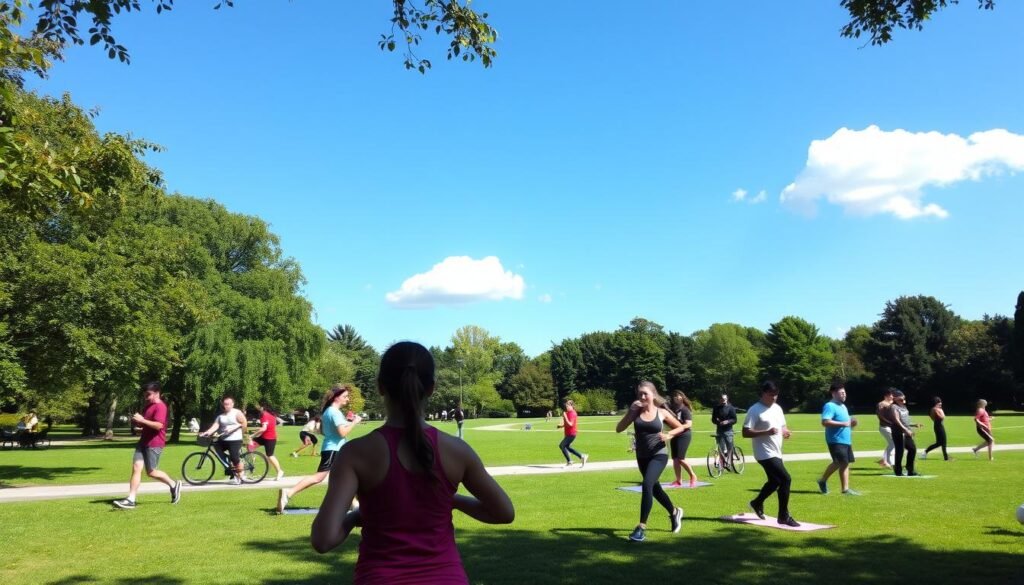Did you know regular exercise can cut lung cancer death rates by up to 3%? This important fact highlights the strong link between being active and preventing lung cancer. Studies show being active is key to good overall health. It also lowers the chance of getting lung cancer.
This is especially true for people who have smoked before. Exercise fights lung cancer by reducing inflammation and boosting immune function. It also betters the balance of body hormones. Understanding this link is crucial for personal wellness and public health efforts against lung cancer.
Research keeps showing how vital a mix of exercise and good food is in fighting lung cancer. To learn more about how eating right and staying active work together, look at what experts say. Their research and articles offer deep insights. Making healthy life choices can clearly lower the risk of lung cancer.
Adopting these habits is key to staying healthy and can be done by anyone looking to improve their health.
Key Takeaways
- Regular exercise is associated with significant reductions in lung cancer mortality.
- Active individuals may experience up to a 3% lower risk of dying from lung cancer.
- Physical activity aids in decreasing inflammation, a key factor in cancer development.
- Healthy lifestyle choices, including diet, correlate with lower cancer risk.
- A connection exists between physical fitness levels and overall lung health.
Understanding Lung Cancer Risk Factors
Lung cancer is a major health threat with many factors leading to its development. It’s important to know these factors to reduce them.
Smoking is the biggest cause, leading to about 87% of lung cancer deaths in the U.S. Smokers are at a much higher risk, with men being 23 times more likely and women 13 times. Quitting smoking cuts this risk in half within five years.
Genetics also matter in lung cancer risk. Having a family history of lung cancer or certain genetic changes increases risk. Knowing your genetic background helps understand your risk better.
Don’t ignore environmental factors. Radon gas is a risk, especially in homes in certain areas. Secondhand smoke is dangerous too, with thousands of harmful chemicals. Working around industrial pollutants also increases lung cancer risk. It’s crucial to avoid harmful environments.
Understanding these risk factors lets you act to lower your chance of getting lung cancer.
The Role of Smoking in Lung Cancer
Tobacco use is the main cause of lung cancer. It’s responsible for about 80% of all lung cancer deaths. This fact shows the strong link between smoking and lung cancer. It tells us why stopping smoking is so important for everyone.
Secondhand smoke is also very harmful. It’s the third leading cause of lung cancer in the U.S. Often, people don’t know how dangerous the air around them is. This issue goes beyond just the smoker, affecting public health too.
Other risk factors play a role in lung cancer. For example, being around radon and asbestos can increase your risk. Workers exposed to asbestos are in more danger, especially if they smoke. This shows that lung cancer comes from many sources, not just tobacco.
Environmental factors, like air pollution, also cause some lung cancers. This reminds us that to fight lung cancer, we need to look at all the risks. Not just smoking, but also where we live and work.
Can Physical Activity Reduce the Risk of Lung Cancer?
Studies have been looking into how physical activity affects the risk of getting lung cancer. These studies show that being active might help protect against this tough disease. Researchers have found strong evidence that exercise can lower the risk of lung cancer.
Research Findings on Physical Activity and Lung Cancer
A big study tracked 1.44 million people to see the effects of physical activity on lung cancer. This study found that active individuals were less likely to get lung cancer. Even those who smoke saw benefits from exercising, reducing their lung cancer risk.
Doing regular exercises, whether they’re moderate or intense, could protect you from lung cancer. This shows the power of staying active for everyone, no matter if they smoke or not.
Statistics Relevant to Physical Activity and Lung Cancer
Looking at lung cancer stats helps us understand exercise’s role better. Studies have shown that exercise lowers the risk of lung cancer in both smokers and non-smokers. Being active has been linked to fewer lung cancer cases, similar to other types of cancer. Below are some interesting numbers:
| Type of Cancer | Risk Reduction |
|---|---|
| Bladder Cancer | 15% |
| Breast Cancer | 12–21% |
| Colon Cancer | 19% |
| Endometrial Cancer | 20% |
| Esophageal Cancer | 21% |
| Kidney Cancer | 12% |
| Stomach Cancer | 19% |
| Lung Cancer | Notable reduction among smokers |
These findings show just how impactful staying active can be. They remind us of the major health perks of daily exercise, not just for lung cancer, but for overall well-being too.
Benefits of Regular Exercise for Overall Health
Exercise does more than make you look good. It boosts your health in many ways. One key benefit is better heart health. This makes you less likely to get heart disease and helps you live longer.
Being fit makes you feel more energetic and keeps your immune system strong. People who exercise often are less likely to get sick. This leads to better health over time. Exercise helps your body and your mind stay strong.
Working out is also great for your mind. It can help you feel less anxious and depressed. It also improves your focus and memory. Exercise helps prevent brain diseases like Alzheimer’s. It helps you lead a balanced life.
The following table highlights key benefits associated with regular exercise:
| Benefit | Description |
|---|---|
| Cardiovascular Health | Improved heart efficiency and lower risk of heart diseases. |
| Boosted Immune Function | Higher resistance to infections and illnesses. |
| Mental Well-Being | Reduced symptoms of anxiety and depression. |
| Longevity | Increased life expectancy through chronic disease management. |
| Cognitive Health | Enhanced memory and attention, lower risk of dementia. |
Understanding the vast benefits should motivate people to start exercising. It leads to a better life quality. Through regular workouts, you can take better care of your health.
Impact of Physical Fitness on Lung Cancer Prevention
Being fit is key to preventing lung cancer. Exercise changes body chemistry to fight inflammation and improve health. Many studies show that being active lowers the risk of cancer, especially lung cancer.
Exercise fights many types of cancer, not just lung cancer. A study in 2016 found that regular activity lowers cancer risk. This is true for people who smoke and those who don’t, emphasizing exercise’s role in lung health.
Making exercise a daily habit offers lasting health rewards. Exercise improves heart health, lung capacity, and muscle strength. These are vital for lowering cancer risk. Plus, it boosts mental well-being, supporting a full-circle approach to health.
| Cancer Type | Risk Reduction (%) | Source |
|---|---|---|
| Bladder Cancer | 15% | 2014 meta-analysis |
| Breast Cancer | 12-21% | 2016 meta-analysis |
| Colon Cancer | 19% | 2016 meta-analysis |
| Endometrial Cancer | 20% | 2016 meta-analysis |
| Esophageal Adenocarcinoma | 21% | 2014 meta-analysis |
| Renal Cancer | 12% | 2013 meta-analysis |
| Stomach Cancer | 19% | 2016 meta-analysis |
Staying active helps the body handle stress and cuts lung cancer risk. Aim for a balanced exercise plan to reach health goals.
The Connection Between Exercise and Smoking Cessation
Starting a routine with exercise and quitting smoking can really boost your success. Regular physical activity helps ease withdrawal symptoms and cut down cravings. Studies show adding exercise to your stop-smoking plan increases your chances of quitting for good.
Adding exercise to your plan to quit smoking offers many benefits. A large study with 1.4 million people found that active folks have a 20 percent lower chance of lung cancer. Doing activities like walking or swimming for 150 minutes each week protects against cancer. This is especially true for people who smoke or used to smoke.
The following table summarizes the impact of physical activity on lung cancer risk among smokers:
| Activity Level | Risk Reduction |
|---|---|
| High Activity (150+ mins/week) | 35% lower risk of lung cancer |
| Moderate Activity (e.g., walking, swimming) | 20% risk reduction for smokers |
| Low Activity | Increased cancer risk |
Moderate physical activities in your free time can protect you from lung cancer. Exercise benefits your whole health and is key for quitting smoking. It boosts your immune system and lung health. This reduces harmful particles in your lungs, helping you quit smoking.

Moderate vs. Vigorous Activity and Lung Cancer Risk
Being active is good for your health, especially for lowering lung cancer risk. Experts have found that both moderate and vigorous exercises are important. By exercising at different levels, one can see significant health benefits.
Insights from Recent Studies
Recent studies show that regular exercise can greatly reduce lung cancer risk. One study looked at 785 people who survived lung cancer. The average age was 69.1 years. During a follow-up of about 3 years, researchers found important results. For those who did moderate to vigorous exercise for at least 60 minutes a week, the risk of dying was lower.
People who mixed moderate exercise with strength activities twice a week had even better results. They had a lower risk of dying from any cause and cancer. Different levels of exercise can improve health and help prevent cancer.
Combining exercises showed interesting effects on lung cancer survivors’ health. Better fitness led to up to 42% lower cancer risk. Just 4.5 minutes of vigorous exercise daily, like stair climbing, cut cancer risk by 20%. This means people with busy schedules can still reduce their cancer risk with short, intense activities.
These studies highlight how both moderate and intense exercises can cut lung cancer risk. They suggest that everyone should find a workout plan that fits their own needs and likes.
Healthy Lifestyle Choices Beyond Exercise
A holistic approach to well-being is key in preventing cancer. Besides regular exercise, people can make many healthy life choices. These choices are:
- Managing body weight: Keeping a healthy weight is crucial. It’s tied to lower cancer risk, with 11% of cancers in women and 5% in men linked to excess weight.
- Limiting alcohol consumption: Too much alcohol can increase your chance of getting various cancers. It’s important to watch how much you drink.
- Avoiding processed foods: Eating too many processed foods might raise your cancer risk. This is because of the added sugars and preservatives.
- Stress management: Long-term stress can harm your health and could be linked to cancer. Finding ways to cope with stress is beneficial for your well-being.
Over 40% of cancer cases and deaths in the U.S. could be prevented. This is done by changing things we have control over. Good eating habits are very important. They help with overall health, support the immune system, and lessen side effects for those fighting cancer.

Making these habits part of everyday life is crucial for lasting health benefits. Embracing a full approach to health lets people take charge of their well-being. This leads to a better life quality and lowers cancer risks.
The Importance of a Balanced Diet in Cancer Prevention
Eating right plays a big part in fighting cancer, especially lung cancer. Studies show that eating lots of fruits, vegetables, and whole grains can help. These foods, full of antioxidants, might lower inflammation and slow cancer growth.
Those fighting lung cancer can see big benefits from choosing the right foods. They should eat things like low-fat dairy, soft vegetables, and juices. Adding oatmeal, rice, and lean proteins like chicken, fish, and tofu can boost their health.
Working with diet experts who know about lung cancer is smart. They can make eating plans that fit each person. Having the help of family and friends is also important. It can make eating right easier for those who feel too tired to cook.
Knowing that over 18% of cancers are linked to being overweight, not moving enough, and bad eating habits shows why eating right matters. Learning more about food can help people make better choices. This can improve health a lot.
To learn more, check out these guidelines on nutrition and physical. It has tips for lung cancer patients to eat better. Joining online support groups is also helpful. It’s a place to get advice and share stories with others.
| Food Group | Examples | Benefits |
|---|---|---|
| Fruits and Vegetables | Broccoli, berries, carrots | Rich in antioxidants, promote overall wellness |
| Whole Grains | Oatmeal, quinoa, brown rice | Provide essential nutrients and fiber |
| Lean Proteins | Poultry, tofu, fish | Support muscle health and recovery |
| Dairy | Low-fat yogurt, cheese | Source of calcium and vitamin D |
Creating an Effective Exercise Routine for Lung Health
Developing an effective exercise plan is key for improving lung health. This is especially true for those with lung cancer. Doing different physical activities boosts overall wellness and helps manage disease side effects.
The American College of Sports Medicine suggests a mix of exercises. This mix should include cardiovascular, resistance, and flexibility training. These types of exercises improve lung health by increasing strength and endurance. For example, aerobic activities like walking or dancing improve heart function and oxygen flow.

It’s important to follow certain guidelines to stick to your exercise plan. Setting goals that you can achieve helps keep you motivated. Tracking your progress lets you see how far you’ve come and keeps you going. Also, getting support from friends, family, or groups can make exercising more fun and keep you involved.
- Strength training: This helps strengthen muscles weakened by cancer symptoms or treatments, and may reduce tiredness.
- Relaxation breathing techniques: These exercises lower stress and anxiety, boosting emotional health.
- Flexibility routines: Stretching can help increase lung capacity and movement, especially for those with breathing challenges.
For a plan that fits your needs, consider talking to an exercise physiologist. These experts can check your fitness level and craft a plan that meets your goals. Whether you begin with gentle walks or more intense workouts, a regular exercise routine can improve your lung health and life quality.
Conclusion
Keeping our lungs healthy is crucial, and one way to do this is by staying active and making smart lifestyle choices. Smoking is a big reason people get lung cancer, causing many deaths each year. Yet studies show that exercise helps protect against this disease, especially if people work out regularly.
Being active helps improve our health and lowers the chance of getting lung cancer. Research has shown that the more you exercise, the less likely you are to get sick. So, making healthy choices can help fight lung cancer and boost overall health.
We should all think about exercising more as part of our daily life. Adding good food and stopping smoking to this mix makes a strong shield against lung cancer. Living a healthy life is a powerful step towards beating lung cancer rates and living better.